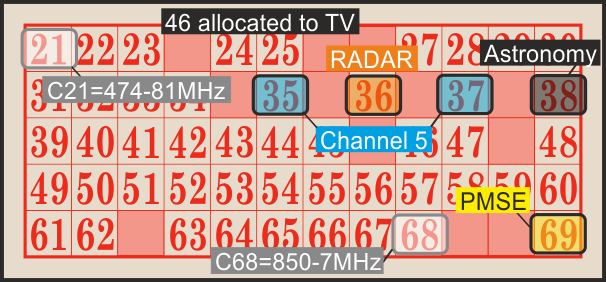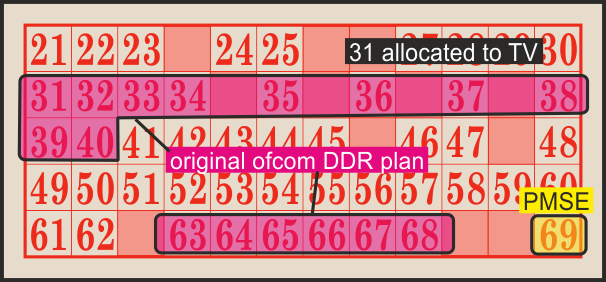Freeview 2020 vs 4G mobile - play Ofcom channel bingo
 Brian Butterworth published on UK Free TV
Brian Butterworth published on UK Free TV Since the launch of "625 line" UHF television, broadcast television services in the UK have used a range of frequencies running from 474MHz to 867MHz, each in blocks of 8MHz.
To make the allocations easier to understand, they have been allocated "channel numbers" starting at C21 and ranging up to C69.
For around four decades the official allocations provided these channel numbers to the BBC, the ITV companies, then Channel 4 (or S4C in Wales) and eventually Channel 5 to provide analogue television services. The following "bingo card" shows the allocations are they were from the 1960s to the millennium.

As you can see, C36 was used for RADAR, C38 for radio astronomy, and C69 was used for "programme making and special events" (PMSE), which generally means the low-power radio equipment used at outside broadcasts.
In the late 1990s, low-power terrestrial digital television launched (as ONdigital, then ITV Digital), these services were squeezed into the existing plan in the UK.
When Freeview became a consumer success, it was decided that the analogue services would be switched off and replaced with just high-powered digital services. As part of this there would be a "digital dividend review" because the digital-only plan would free up some of the TV frequencies, as digital channels can co-exist more efficiently than the outdated analogue TV could. The plan looked like this:

However, it became clear during early 2009 that the 790-862 MHz frequencies would be co-ordinated over the whole of Europe for fourth-generation mobile broadband (Digital Dividend - changes to the 800MHz ). These new mobile broadband services are referred to as "4G" and "Long Term Evolution" (LTE). This left the plan as we find it today:

One of the effects is that some transmitters in switched-over regions are moving services from C61 and C62 into next year - 2013 - post-switchover changes to Freeview transmission frequencies.
What does the future hold? Part two: Ofcom channel bingo II - introducing the bands
Reducing the service to three multiplexes, would be the fair option. Then all transmitters would have the same number of channels.
But I expect that one or two people might complain.
| link to this comment |
Mark's: mapM's Freeview map terrainM's terrain plot wavesM's frequency data M's Freeview Detailed Coverage
4:11 PM
I think I understand. Thank God that the powers that be have not arranged things such that any TV equipment that I might buy would not be made obsolete by this rearrangement
| link to this comment |
9:37 AM
Yes, our TV equipment will now soon be obsolete, due to lack of space for High Def.
Instead we will have the mobile operators fighting to give us the latest gimicks.
| link to this comment |
4:20 PM
In this day and age after DSO1 we need more Muxes not less, all TVs currently sold are not compatible with the new MPEG4 H2.65 HVEC Standard, so either we buy a box/PVR that is or we have to buy completely new TV sets
Is this the new future where we buy replacements every one or two years, think about the environment and our money that we will be spending both require huge amounts of money and time?
| link to this comment |
4:26 PM
Does this mean that if there are only 3 multiplexes that we would loose half of the channels that are available now? that seems like a backwards step, or will they fit all the channels onto the 3 multiplexes.
| link to this comment |
6:14 PM
A change to DVB-T2 (used for Freeview HD) or even its successor H2.65 is more than capable to be used to cram more SD services instead into smaller amount of space at current quality.
Problem is existing devices are not upgradable.
They should really considered doing what possible to put everyone on Freesat as standard and lobbied Virgin Media to create an 'Free' tier (Freesat/Freeview).
| link to this comment |
I give up, I'm sticking to satellite, It's much simpler.
| link to this comment |
Ian's: mapI's Freeview map terrainI's terrain plot wavesI's frequency data I's Freeview Detailed Coverage
6:38 PM
Halifax
Wendy.Yes that is a possibility more and ultimately all HD broadcasting on possibly three multiplexes,and when Ultra High Definition (UHD) becomes the norm by around 2050 possibly only one multiplex with up to and maybe over 1,000 UHD channels ?
| link to this comment |
Mark's: mapM's Freeview map terrainM's terrain plot wavesM's frequency data M's Freeview Detailed Coverage
9:05 PM
Mark Fletcher: I can't help wondering if there will be no more free-to-air HD channels beyond the basic PSBs, albeit that the regional variants will probably be HD eventually.There is a general move among broadcasters to offer HD only on subscription channels. The government and regulators now seem to regard broadband as the "must have" service, no matter what happens to broadcast TV.- why are Ofcom so keen to break the control Sky have over new movies? Something to make broadband more attractive to TV viewers, perhaps? Personally I think this is changing over to pay TV by the back door, with Freeview and Freesat eventually offering very little by way of general entertainment.
| link to this comment |
9:31 PM
Ian: Satellite has its fair share of complications. With so many different orbital positions being used by the countries that transmit free-to-air services it requires a receiver that supports Diseqc to switch between the LNBs. That is in addition to every tuner needing a cable back to the LNB. Then do you run the receiver in Non-Freesat mode to get all the available channels, or go for the EPG then fiddle about tuning in all the extras that Freesat don't give you, (like Sky News!) It makes diplexing a second aerial to receive the Freeview COM muxes sound easy.
| link to this comment |